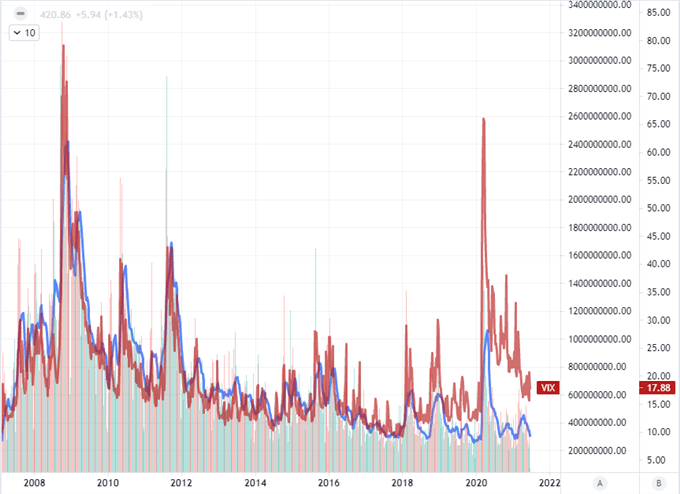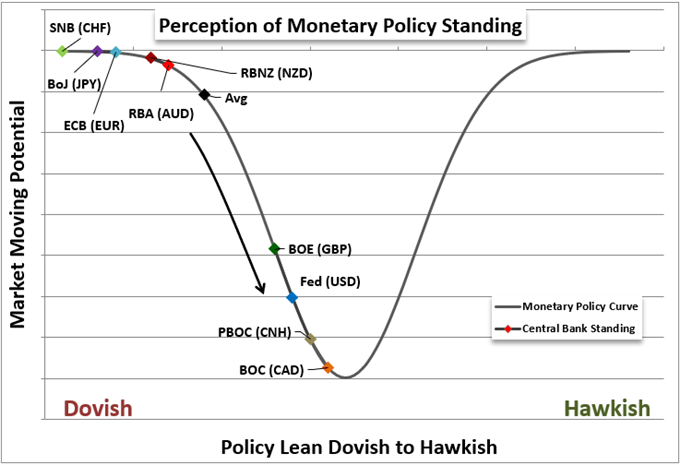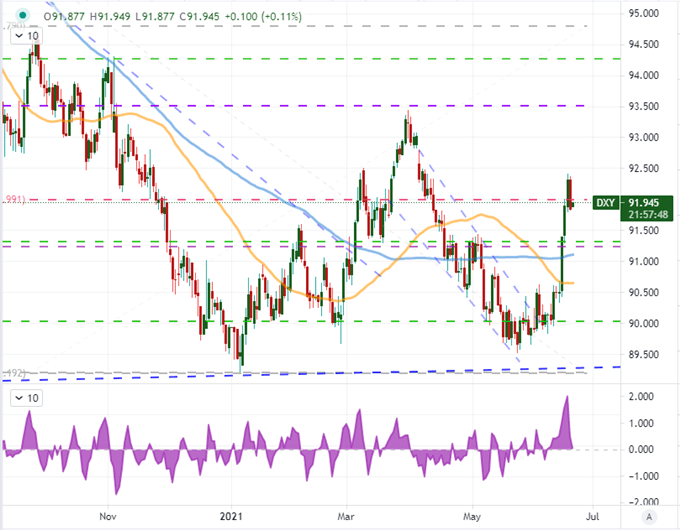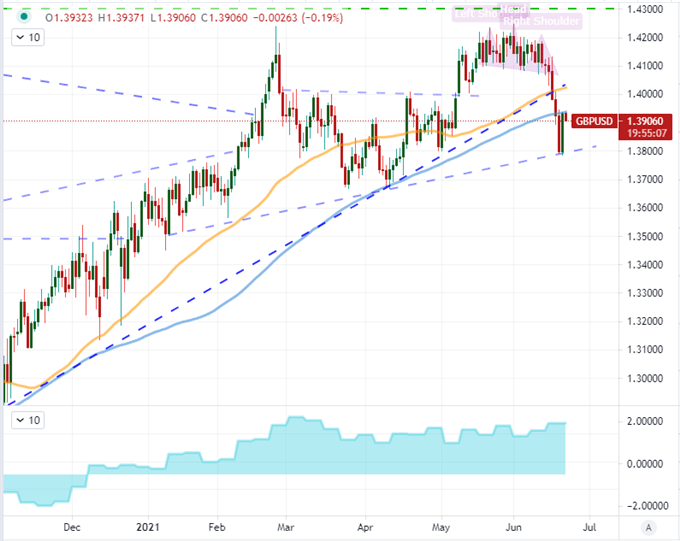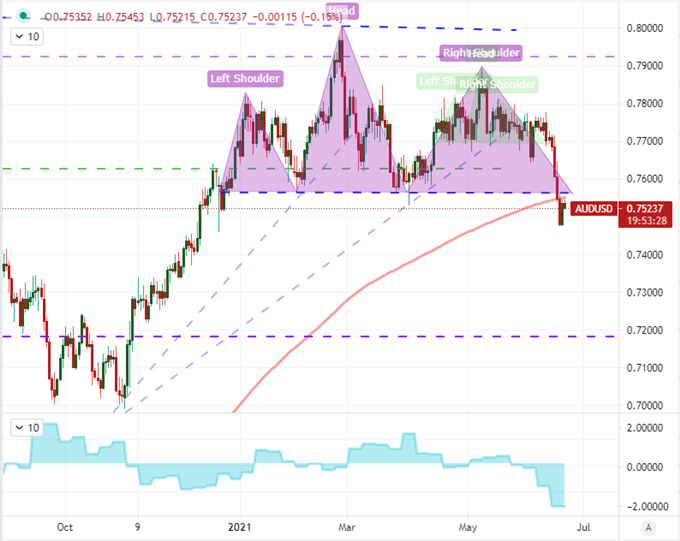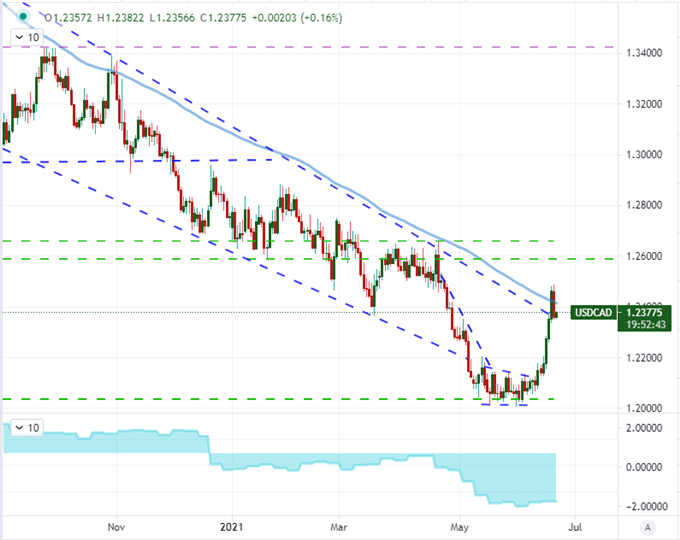Dow, Nasdaq, Dollar, GBPUSD, USDCAD and AUDUSD Talking Points:
- The slump that spread across risk assets to end this past week led to a general bounce to start this new week, but where does conviction lay?
- Fed normalization as a risk to over-extended risk exposure may be an important fundamental theme, but market conditions of volatility and participation are my top priority
- A retreat from the Dollar suits the ‘difficult to trend’ environment, but where does that leave technical breaks like those from GBPUSD, AUDUSD and USDCAD?
A Full Risk Breakdown That Is Snuffed Out by Liquidity
Risk Aversion was in full swing through the second half of this past week, which had me wondering whether we may have struck the exact speculative chord that would override a seasonal drain on liquidity. I was out Friday when the concentrated risk aversion via the likes of the Dow Jones Industrial Average and concurrent bid in the US Dollar spread to other corners of the financial system. Was this a slow-burn response to the FOMC‘s signaling earlier rate hikes than the market was prepared for or perhaps it was simply a disruption caused by the confluence of derivative products expiring (what is called a ‘quad witching’ event)? It is important to try and distinguish the motivation for the move as the ability of generating follow through in adverse market conditions fully depends on the source of inspiration. Given the broad bounce in global indices and other sentiment-linked assets Monday, it would seem a point for a temporary disruption. However, the bounce for the likes of the Dow doesn’t erase the pain of the preceding week’s worth of retreat. It is important to keep as closer a tab on market volume and correlation across assets as direction on benchmarks.
Chart of the Dow Jones Industrial Average ETF with 50-DMA and Volume (Daily)
Chart Created on Tradingview Platform
Speaking of volume, there was a notable divergence in the turnover for Monday’s bounce relative to the tumble from the trading sessions that preceded the move. Under normal conditions, volume on steady climb tends to be more reserved than a heavy selling event. However, when the effort is to overcome thinned market conditions with a return to a mature bull trend, deeper commitment is of considerable importance. As we find the markets seeking out a collective view on its speculative bearings, the interaction of liquidity with directionality will give invaluable perspective on what the market is capable of and perhaps the collaborative intention.
VIX Volatility Index Overlaid with 20-Day Moving Average of SPY Volume (Weekly)
Chart Created on Tradingview Platform
Monetary Policy Speculation Follows the Market Into the New Trading Week
There is no doubt that last week’s FOMC rate decision carries serious weight with both US and global markets. The world’s largest central bank was a leader of the massive stimulus program that has now become a foundation of modern monetary policy, so it makes sense that it represents the symbolic trailblazer for an eventual reversal to normalize from its extreme position. With the blackout period around the official rate decision passed and the market clearly struggling to digest the shifted rate forecast from the SEP, members of the central bank have picked up the mantel of attempting to instill calm by clarifying the path forward. This past session, New York Fed President John Williams reiterated that the economy had not recovered sufficiently in his mind to justify a reduction in stimulus. South Louis Fed President James Bullard took a more mixed position by affirming they were starting to talk on taper but the taper this time around could not be on autopilot. Meanwhile, Dallas Fed President Robert Kaplan says he favors easing off the ‘accelerator’ sooner rather than later. Though not a policy official, I felt renowned investor Ray Dalio’s remarks that irrespective of the central bank’s intentions, it couldn’t tighten “a lot” without “big, negative effects” on the markets. I believe that to be spot on after years of establishing central bank support as the bedrock on which such excessive market heights have been scaled.
Chart of Relative Monetary Policy Standings of Major Central Banks
Chart Made by John Kicklighter
For the Dollar, the disparity in monetary policy bearing for the US relative to its global counterparts likely counts for more of the currency’s climb this past week than the safe haven bid that arose only through Friday. The central bank rhetoric this past session wasn’t likely a strong headwind to push the DXY Dollar Index to its pullback – though a bounce in risk appetite likely worked in conjunction with a natural urge to moderate the strongest three-day rally for the benchmark since the height of the pandemic. If yield differentials is a fundamental theme capable of shifting the market, I believe that the run of Fed updates due throughout the week will carry substantial weight. Today, Fed Chair Jerome Powell is set to testify to Congress on the pandemic lending programs. His prepared remarks were pre-released so it will be the questions posed to the central banker that carry any weight. Further ahead, the Fed’s bank stress test results and the Friday PCE deflator – the Fed’s preferred inflation reading – will be the more decisive updates on policy expectations.
Chart of DXY Dollar Index with 50 and 100-DMAs, 3-Day Rate of Change (Daily)
Chart Created on Tradingview Platform
What To Do About Those Majors with Technical Breaks?
With the Dollar struggling to find follow through, there are pairs like EURUSD and USDJPY which are still moving within large technical ranges and thereby would be suitable for market conditions that moderate back into an uncomfortable congestion. Alternatively, there are certain pairs that have put in for impressive technical breaks that will struggle for their next moves. Consider GBPUSD which broke its post-Pandemic recovery trend channel support and the 100-day moving average. Net futures speculative positioning is notably showing confidence that the bullish wave will be sustained.
Chart of GBPUSD with 50 and 100-DMAs and COT Net Spec Futures Positioning (Daily)
Chart Created on Tradingview Platform
Another Dollar pair with a notable technical correction is AUDUSD which cleared the head-and-shoulders pattern that has formed throughout 2021 along with the 200-day moving average in the process. Given last month’s false breakout reversal around the smaller congestion pattern with a floor at 0.7700, traders are probably prepped for a quick correction from a false signal. In contrast to the Cable, net speculative futures positioning for AUDUSD shows the most bearish conviction since June of last year.
Chart of the AUDUSD with 200-Day Moving Average and COT Net Spec Futures Positioning (Daily)
Chart Created on Tradingview Platform
The pair that has held the most productive anti-Dollar progress over the past three months – and an impressive year’s worth of charge before that – was USDCAD. When the Greenback’s rebound was a moderate signal on the horizon, this pair freely moved in a well establish range (a descending trend channel). Yet, the bullish pressure just in the second half of this past week has further pushed us through the other side of the long-standing bullish pattern. Given how similar these currencies are in regional economic disposition, the focus on relative monetary policy will likely be more prominent – an interesting case given the BOC’s own taper two months back.
Chart USDCAD with 100-Day Moving Average and COT Net Spec Futures Positioning (Daily)
Chart Created on Tradingview Platform
.


